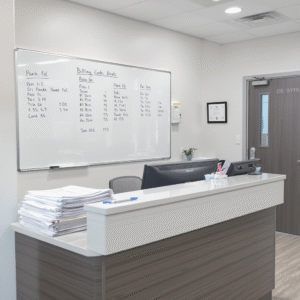Hidden Ways Claim Denials Are Costing Your Practice: The True Financial Impact You’re Not Seeing
Costing
Costing
The notification arrives in your inbox like clockwork: another claim denial. Your billing team sighs, prepares the appeal paperwork, and files it away as just another cost of doing business. But what if we told you that this “routine” denial is actually bleeding your practice dry in ways you never imagined?
While most healthcare practices focus on the obvious costs of claim denials—the immediate loss of expected revenue—the reality is far more complex and financially devastating. The hidden expenses lurking beneath each denial create a cascade of costs that can silently erode your practice’s profitability, staff morale, and long-term sustainability.

The Obvious Costs vs. The Hidden Reality
When a claim gets denied, most practice administrators immediately think about the delayed payment. If it’s a $200 office visit that gets rejected, they see $200 in lost revenue. This surface-level thinking, however, barely scratches the surface of the true financial impact.
The American Medical Association reports that the average medical practice spends between $25 to $118 per claim denial to investigate, reprocess, and collect payment. But even these figures don’t capture the complete picture of how denials systematically drain resources from your practice.
Administrative Burden: The Time Thief
Every denied claim triggers an administrative avalanche that consumes far more time than most practices realize. When your billing specialist receives a denial, they must stop their current workflow to investigate the reason. This investigation process involves reviewing the original claim, examining the denial code, researching payer policies, and determining the appropriate course of action.
This interruption doesn’t just affect one person—it creates a ripple effect throughout your administrative team. The billing specialist may need to consult with the provider about documentation, coordinate with the front desk about patient information, and potentially reach out to the insurance company for clarification. Each of these interactions pulls additional staff members away from their primary responsibilities.
Consider this scenario: A single complex denial might require two hours of investigation time from your billing specialist, thirty minutes of provider consultation, and fifteen minutes of coordination with front desk staff. At average healthcare administrative wages, this single denial has already cost your practice approximately $75 in labor costs before any corrective action has been taken.
The Revenue Cycle Disruption
Claim denials don’t just delay individual payments—they disrupt your entire revenue cycle. When claims are denied, they exit the normal payment timeline and enter a separate, more labor-intensive appeals process. This creates gaps in your expected cash flow that can cascade into serious financial planning challenges.
The disruption extends beyond immediate cash flow issues. Denied claims often require multiple resubmissions, each with their own processing time. A claim that should have been paid within 30 days might now take 90 days or more to resolve, assuming it’s ultimately successful. During this extended period, your practice is essentially providing free financing to insurance companies while struggling to manage your own cash flow requirements.
This delayed payment cycle forces many practices to rely more heavily on credit lines or delay their own payments to vendors and staff. The interest costs and potential late fees associated with these financial accommodations represent another hidden cost of claim denials that rarely appears in practice financial analyses.
Staff Productivity and Morale Costs
The psychological impact of constant claim denials on your staff creates costs that are difficult to quantify but impossible to ignore. Billing specialists who spend their days fighting denials experience higher levels of job stress and frustration. This emotional toll translates into decreased productivity, higher turnover rates, and increased recruitment costs.
When your best billing specialist leaves because they’re burned out from dealing with endless denials, the replacement costs extend far beyond just hiring expenses. New staff require training, make more errors during their learning period, and take months to reach full productivity. During this transition period, denial resolution times increase, creating even more financial pressure on your practice.
The frustration isn’t limited to billing staff. Providers often become involved in denial appeals, particularly when documentation issues are cited. Time spent by physicians and nurse practitioners on administrative appeals represents some of the most expensive labor in your practice being diverted from revenue-generating patient care activities.
Patient Relationship Consequences
Perhaps the most insidious hidden cost of claim denials involves the damage to patient relationships and your practice’s reputation. When insurance claims are denied, patients often receive unexpected bills or confusing statements about their coverage. Many patients assume these problems reflect poor management by your practice rather than insurance company policies.
Frustrated patients require additional staff time to explain billing issues, coordinate with insurance companies, and provide reassurance about the situation. Your front desk staff, already handling a full workload of scheduling and patient inquiries, must now become insurance advocates and customer service representatives for problems they didn’t create.

Some patients, faced with unexpected bills resulting from claim denials, may delay or avoid future appointments. Others might choose to find new providers who they perceive as having fewer billing complications. The lifetime value of lost patients represents a significant hidden cost that many practices never fully calculate or consider.
Technology and System Inefficiencies
Most practice management systems aren’t optimized for handling the complex workflows associated with claim denials. Staff often resort to manual tracking methods, spreadsheets, and paper-based appeals processes that create additional inefficiencies and opportunities for errors.
These workaround systems require maintenance and monitoring that pulls staff away from other productive activities. Important deadlines for appeals might be missed due to inadequate tracking systems, resulting in write-offs that could have been avoided with better processes.
The lack of integrated denial management tools also makes it difficult to identify patterns in denials that could be addressed proactively. Without proper analytics, practices continue making the same mistakes that generate denials, creating a cycle of unnecessary costs and inefficiencies.
Opportunity Costs and Lost Growth Potential
Every hour your staff spends managing claim denials is an hour not spent on activities that could grow your practice. Instead of focusing on patient acquisition, service improvements, or expanding clinical services, your administrative resources are consumed by repetitive, defensive activities that generate no additional revenue.
The opportunity costs extend to provider time as well. Physicians who spend time on appeal documentation and denial reviews are not seeing additional patients or focusing on clinical quality improvements that could enhance the practice’s reputation and patient satisfaction.
Vendor and
Patient Relationship Consequences
Many practices, overwhelmed by the complexity of denial management, turn to external billing services or specialized software solutions. While these services can provide value, they also represent additional costs that directly result from the denial problem. Monthly fees for denial management software, percentage-based billing service charges, and consultant fees for revenue cycle optimization all trace back to the fundamental issue of claim denials.
These external costs often become permanent fixtures in practice budgets, creating ongoing expenses that continue even after denial rates might improve. The decision to outsource billing or purchase specialized software represents a significant financial commitment that practices might not need if denial rates were properly managed.

The Compounding Effect
The most dangerous aspect of hidden denial costs is how they compound over time. A practice that experiences a high denial rate doesn’t just face higher costs in the current month—they face systematically higher operating costs that persist and grow over time.
Staff members who become accustomed to high denial rates may begin to accept them as inevitable, leading to decreased efforts to prevent denials proactively. This acceptance creates a culture where denial-related costs become normalized and embedded in the practice’s cost structure.
Taking Action: Recognition and Response
Understanding these hidden costs represents the first step toward addressing them. Practices that want to combat the true financial impact of claim denials must look beyond simple denial rates and examine the total cost of ownership for their revenue cycle management.
This examination should include detailed time tracking for denial-related activities, analysis of staff turnover in billing roles, measurement of patient satisfaction related to billing issues, and calculation of opportunity costs associated with administrative burden.
The goal isn’t necessarily to eliminate all claim denials—some level of denials is inevitable in the complex world of healthcare billing. Instead, the objective should be to minimize the total cost impact through improved processes, better staff training, enhanced technology solutions, and proactive denial prevention strategies.
Conclusion
Claim denials represent far more than simple delays in payment. They create a web of hidden costs that systematically drain resources from medical practices, reduce staff productivity, damage patient relationships, and limit growth potential. By recognizing and quantifying these hidden costs, practice administrators can make more informed decisions about investments in denial prevention and management systems.
The practices that thrive in today’s challenging healthcare environment are those that understand the true cost of claim denials and take comprehensive action to address them. The investment in proper denial management isn’t just about improving cash flow—it’s about creating a more efficient, profitable, and sustainable practice for the long term.
Every denied claim represents an opportunity to identify and address systemic issues that are costing your practice far more than the face value of the original claim. The question isn’t whether you can afford to invest in better denial management—it’s whether you can afford not to.



